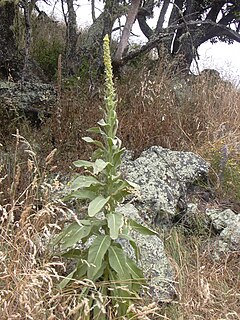
A rose is a woody perennial flowering plant of the genus Rosa, in the family Rosaceae, or the flower it bears. There are over three hundred species and thousands of cultivars. They form a group of plants that can be erect shrubs, climbing, or trailing, with stems that are often armed with sharp prickles. Flowers vary in size and shape and are usually large and showy, in colours ranging from white through yellows and reds. Most species are native to Asia, with smaller numbers native to Europe, North America, and northwestern Africa. Species, cultivars and hybrids are all widely grown for their beauty and often are fragrant. Roses have acquired cultural significance in many societies. Rose plants range in size from compact, miniature roses, to climbers that can reach seven meters in height. Different species hybridize easily, and this has been used in the development of the wide range of garden roses.

Liriodendron is a genus of two species of characteristically large deciduous trees in the magnolia family (Magnoliaceae).
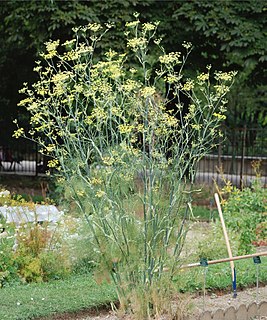
Fennel is a flowering plant species in the carrot family. It is a hardy, perennial herb with yellow flowers and feathery leaves. It is indigenous to the shores of the Mediterranean but has become widely naturalized in many parts of the world, especially on dry soils near the sea-coast and on riverbanks.

Witch-hazels or witch hazels are a genus of flowering plants in the family Hamamelidaceae, with four species in North America, and one each in Japan (H. japonica) and China (H. mollis). The North American species are occasionally called winterbloom.

Tagetes is a genus of annual or perennial, mostly herbaceous plants in the sunflower family (Asteraceae). It was described as a genus by Linnaeus in 1753.

Ferula is a genus of about 170 species of flowering plants in the carrot family, native to the Mediterranean region east to central Asia, mostly growing in arid climates. They are herbaceous perennial plants growing to 1–4 m tall, with stout, hollow, somewhat succulent stems. The leaves are tripinnate or even more finely divided, with a stout basal sheath clasping the stem. The flowers are usually yellow, rarely white, produced in large umbels. Many plants of this genus, especially F. communis are referred to as "giant fennel," although they are not fennel in the strict sense.

Cota tinctoria, the golden marguerite, yellow chamomile, or oxeye chamomile, is a species of perennial flowering plant in the sunflower family. Other common names include "dyer's chamomile", "Boston daisy", "Paris daisy". In horticulture this plant is still widely referred to by its synonym Anthemis tinctoria.

Rhinanthus minor, the yellow rattle, little yellow rattle, hayrattle or cockscomb, is a flowering plant in the genus Rhinanthus in the family Orobanchaceae, native to Europe, northern North America, and Western Asia.

Nelumbo lutea is a species of flowering plant in the family Nelumbonaceae. Common names include American lotus, yellow lotus, water-chinquapin, and volée. It is native to North America. The Linnaean binomial Nelumbo lutea (Willd.) is the currently recognized name for this species, which has been classified under the former names Nelumbium luteum and Nelumbo pentapetala, among others.

Saxifraga is the largest genus in the family Saxifragaceae, containing about 440 species of holarctic perennial plants, known as saxifrages or rockfoils. The Latin word saxifraga means literally "stone-breaker", from Latin saxum + frangere. It is usually thought to indicate a medicinal use for treatment of urinary calculi, rather than breaking rocks apart.

Podophyllum is an herbaceous perennial plant in the family Berberidaceae, described as a genus by Linnaeus in 1753. In the past, several species were included in the genus, but all but one have been transferred to other genera (Dysosma, Pilea, and Sinopodophyllum). The one remaining species is Podophyllum peltatum, with common names mayapple, American mandrake, wild mandrake, and ground lemon. It is widespread across most of the eastern United States and southeastern Canada.
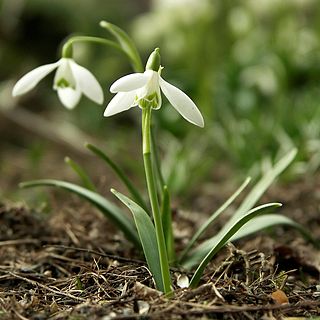
Galanthus nivalis, the snowdrop or common snowdrop, is the best-known and most widespread of the 20 species in its genus, Galanthus. Snowdrops are among the first bulbs to bloom in spring and can form impressive carpets of white in areas where they are native or have been naturalised. They should not be confused with the snowflakes, in the genera Leucojum and Acis.

Linaria vulgaris is a species of toadflax (Linaria), native to most of Europe, northern Asia, the United Kingdom, Spain, east to eastern Siberia, and western China. It has also been introduced and is now common in North America.

Calendula officinalis, the pot marigold, ruddles, common marigold or Scotch marigold, is a plant in the genus Calendula of the family Asteraceae. It is probably native to southern Europe, though its long history of cultivation makes its precise origin unknown, and it may possibly be of garden origin. It is also widely naturalised further north in Europe and elsewhere in warm temperate regions of the world.

A noxious weed, harmful weed or injurious weed is a weed that has been designated by an agricultural authority as one that is injurious to agricultural or horticultural crops, natural habitats or ecosystems, or humans or livestock. Most noxious weeds have been introduced into an ecosystem by ignorance, mismanagement, or accident. Some noxious weeds are native. Typically they are plants that grow aggressively, multiply quickly without natural controls, and display adverse effects through contact or ingestion. Noxious weeds are a large problem in many parts of the world, greatly affecting areas of agriculture, forest management, nature reserves, parks and other open space.
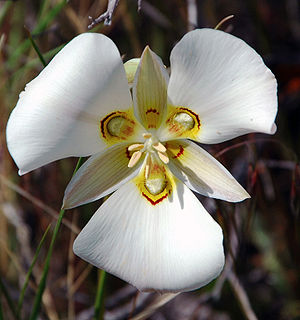
Calochortus nuttallii — known as sego lily — is a bulbous perennial which is endemic to the Western United States.

Solidago juncea, the early goldenrod, plume golden-rod, or yellow top, is North American species of herbaceous perennial plants of the sunflower family native to eastern and central Canada and the eastern and central United States. It grows from Nova Scotia west to Manitoba and Minnesota south as far as northern Georgia and northern Arkansas, with a few isolated populations in Louisiana and Oklahoma.
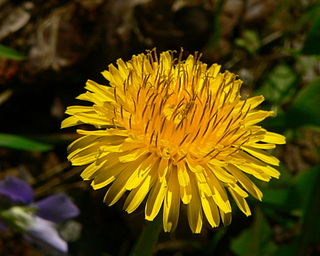
Taraxacum is a large genus of flowering plants in the family Asteraceae, which consists of species commonly known as dandelions. They are native to Eurasia and North America, but the two commonplace species worldwide, T. officinale and T. erythrospermum, were introduced from Europe and now propagate as wildflowers. Both species are edible in their entirety. The common name dandelion is given to members of the genus. Like other members of the Asteraceae family, they have very small flowers collected together into a composite flower head. Each single flower in a head is called a floret. In part due to their abundance along with being a generalist species, dandelions are one of the most vital early spring nectar sources for a wide host of pollinators. Many Taraxacum species produce seeds asexually by apomixis, where the seeds are produced without pollination, resulting in offspring that are genetically identical to the parent plant.
Flavum is a Latin word meaning "yellow". It is often used in taxonomy for species names typically in scientific names for animals and plants to refer to the flower colour or other aspect of the species.


